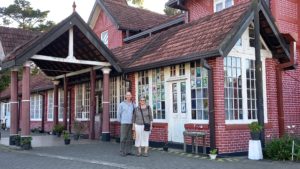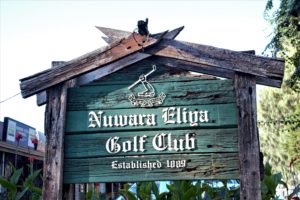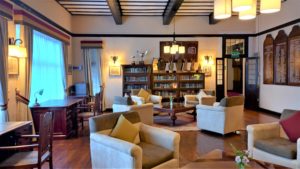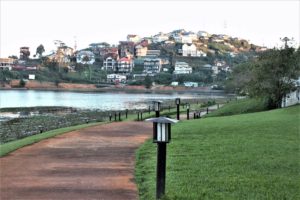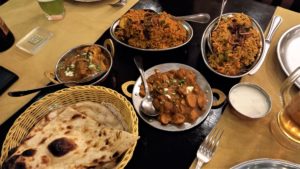Whilst staying at the Langdale Boutique Hotel, we took in an afternoon sightseeing trip to nearby Nuwara Eliya, a 30-minute drive away. The Sri Lankan city is often dubbed “Little England” due to its cool climate and colonial-era bungalows.
Having passed the Nuwara Eliya Golf Club, established in 1889, and huge old fir trees, we spotted Victoria Park. Originally known as the Hakgala Botanical Garden, it was formally renamed in 1897 to commemorate Queen Victoria’s Diamond Jubilee.
Opposite the park was the oldest working post office in Sri Lanka. Built by the British in 1894, the Tudor-style, red-brick building with a clock spire was a magnificent sight. However, I was on a mission: to have stamps printed with my photograph on them. Our guide, Ahmed, led us to the philately counter, where, having blue toothed a photo to the guy behind the desk, he transformed it into a sheet of 20 stamps bearing my picture for 1,500 Rupees (£5). Whilst it was rather a vanity project, it made my day, and my stamps are used decoratively on hand-delivered birthday cards.
Back in the car, we drove up through St Andrew’s Hotel (now part of the Jetwing group), to see its famous topiary gardens. Unfortunately, they were not looking their best, probably due to Covid, so we continued past the racecourse, spotting places and streets with familiar names like the Windsor Hotel, The Edgeware and Queen’s Road.
Passing the summer residence of the Prime Minister, our next stop was The Hill Club, which granted us temporary membership for 200 Rupees each (80p). Established in 1876 by British coffee planters, it is now a three-star hotel and a throwback to less modern times. At 5.30pm, the male staff were resplendent in either dark suits or dinner jackets. In the formal dining room, the menu on display revealed lots of British staples like chicken and vegetable stew with profiteroles for pudding. Here the dress code for gentlemen was lounge suit and tie, although there was also a casual dining room.
Various sitting rooms, some for games and others for TV, had faded brown furniture you might have last seen in your nan’s house. There were two snooker rooms (one smoking and one non-smoking) with signs ‘for the convenience of players, silence is essential’. Stuffed animal heads on the walls abounded. The Queen had visited twice (1949 and 2017), and a canteen of ivory handled cutlery used at the time was on display. Having strolled through the manicured gardens we set off for our final stop of the afternoon.
Lake Gregory was constructed during the period of British Governor Sir William Gregory in 1873. There was a modest entrance fee, and although there are lots of water-based activities during the day, most visitors like us, were content to stroll through the gardens or along the shore. From here we could see Sri Lanka’s highest peak (Mt Pidurutalagala or Mt Pedro in English) with its tall telecommunications tower. Eventually, the midges appeared, and dinner called.
Ahmed had suggested eating at the Grand Indian in The Grand Hotel. Assuming it would be a grand affair with ornate dining room, I wondered whether I’d be appropriately dressed. However, it turned out to be a casual experience, in a relatively small, separate building.
At 6.30pm, it wasn’t too busy and although ordering should have been done via a QR code, Ahmed helpfully sourced paper menus, as we would have found it difficult to navigate the comprehensive selection on our mobiles.
We decided to be vegetarian and ordered a vegetable biriyani, tawa mushrooms (cooked with pepper and onions in a thick sauce), aloo gobi (potato and cauliflower) and a garlic naan. The food was placed between us, with the waiter serving out on to our silver plates. Despite reasonable prices, we had a feast which nearly defeated us. With a couple of large bottles of Lion beers it was the perfect end to our sightseeing.
This was obviously a popular place as during our meal we noticed people either being turned away or choosing to eat outside despite the cool temperature.
